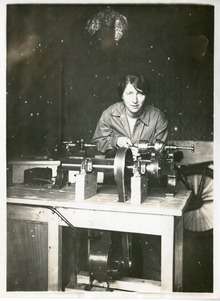Lili Bleeker
| Caroline Emilie "Lili" Bleeker | |
|---|---|
|
Dr. Caroline Bleeker | |
| Born |
January 17, 1897 Middleburg |
| Died |
November 12, 1985 (aged 88) Zeist |
| Nationality | Dutch |
Caroline Emilie "Lili" Bleeker (17 January 1897 – 12 November 1985) was a Dutch physicist known for her work on the design and production of scientific instruments.
Early life and education
Lili Bleeker was born in 1897 to John Lambert Bleeker and his wife Martha Gerhardina Döhne and was the youngest of 5 children. She grew up in the Dutch city of Middleburg.[1] Bleeker attended Lange Sint high school in Pietersstraat, Middelburg, the Netherlands. Because her mother discouraged her from continuing her studies, she taught at a secondary school to pay her way at the University of Utrecht. From 1919 to 1926 she was the head lab assistant in the physics department at Utrecht and on January 1, 1926 named as sole head assistant.[2] She received her PhD in physics from Utrecht University with her thesis on alkaloid spectra.[1][2]
Career
After receiving her degree, Bleeker started a successful consultancy which quickly grew from her living room to a small factory building. Bleeker opened a factory for the construction of scientific and optical equipment.[2] Until 1936, the company's focus was on manufacturing hardware for the laboratory and precision electric measuring instruments. However, in 1936, Bleeker decided to start an optical workshop, and in 1937 started production on optical instruments. Her production spearheaded the optical industry in the Netherlands, which was previously nonexistent. In 1938, Bleeker entered negotiations with the Dutch military to develop binoculars for them. In 1940, The Netherlands entered World War II. Bleeker stopped production of binoculars in her factory because she did not want to produce any products for the German army. She did not stop production entirely in her factory, however. Bleeker developed microscopes for Dutch universities and their students. Bleeker also hid Jewish citizens in her factory, and eventually in 1944, someone told the German authorities about her doing so. She was able to successfully mislead the German authorities and successfully let the Jewish people in hiding escape, but Bleeker and her husband had to go into hiding.[2] Her factory was closed down during that time. After the war, she opened a new factory, which was the first in the world to make the phase contrast microscope invented by Frits Zernike.[1][2]
Awards and honors
- There is a building at Utrecht University named after Bleeker.[2]
